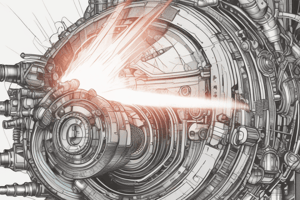Podcast
Questions and Answers
What type of groove weld is typically used for thicker sections?
What type of groove weld is typically used for thicker sections?
- Single J-groove weld
- Single U-groove weld
- Single V-groove weld
- Double V-groove weld (correct)
Which zone in a fusion-welded joint does not undergo any changes from the welding process?
Which zone in a fusion-welded joint does not undergo any changes from the welding process?
- Fusion zone
- Unaffected base metal zone (correct)
- Heat-affected zone
- Weld interface
What is a recommended technique to minimize distortion in a weldment?
What is a recommended technique to minimize distortion in a weldment?
- Tack welding at a single point along the joint
- Avoiding the use of welding fixtures
- Use of excessive filler metal
- Preheating base parts to reduce thermal stresses (correct)
What is the purpose of using heat sinks in the welding process?
What is the purpose of using heat sinks in the welding process?
Which category of welding processes includes arc welding, resistance welding, and oxyfuel gas welding?
Which category of welding processes includes arc welding, resistance welding, and oxyfuel gas welding?
What is the representative welding process in the Solid-State Welding group that involves Sheet Metal Cladding?
What is the representative welding process in the Solid-State Welding group that involves Sheet Metal Cladding?
Which of the following is NOT one of the five basic types of joints in welding?
Which of the following is NOT one of the five basic types of joints in welding?
In the category of Automation in Welding, what type of welding involves various forms of mechanization and automation such as machine welding, automatic welding, and robotic welding?
In the category of Automation in Welding, what type of welding involves various forms of mechanization and automation such as machine welding, automatic welding, and robotic welding?
What distinguishes fusion welding processes from solid-state welding processes?
What distinguishes fusion welding processes from solid-state welding processes?
Why is a filler metal added in many fusion welding operations?
Why is a filler metal added in many fusion welding operations?
What is the key characteristic of solid-state welding processes?
What is the key characteristic of solid-state welding processes?
How do fusion welding processes differ from solid-state welding processes in terms of temperature?
How do fusion welding processes differ from solid-state welding processes in terms of temperature?
Study Notes
Groove Welds and Joint Properties
- Groove welds are typically used for thicker sections, providing strength and integrity in the joints.
- The base metal zone in a fusion-welded joint remains unaffected by the welding process, maintaining its original properties.
Distortion Minimization Techniques
- To minimize distortion in a weldment, proper joint design and techniques such as intermittent welding or sequencing are recommended.
Heat Sinks in Welding
- Heat sinks are employed in the welding process to absorb excess heat, thereby helping to prevent warping and distortion of the workpiece.
Categories of Welding Processes
- The category of welding processes that includes arc welding, resistance welding, and oxyfuel gas welding is known as fusion welding.
Solid-State Welding Representative Process
- A representative welding process in the Solid-State Welding group related to Sheet Metal Cladding is explosive welding.
Types of Joints in Welding
- Edge joint is NOT classified among the five basic types of joints in welding, which include butt, lap, corner, tee, and flange joints.
Automation in Welding
- In the category of Automation in Welding, the type involving mechanization and automation is termed automatic welding, which encompasses machine and robotic welding.
Fusion vs. Solid-State Welding Processes
- Fusion welding processes utilize high temperatures to melt the base materials together, while solid-state welding processes join materials without melting them, thus avoiding significant alterations in the base materials.
Role of Filler Metal
- A filler metal is added in many fusion welding operations to enhance the strength and integrity of the joint and to fill any gaps between the workpieces.
Key Characteristic of Solid-State Processes
- The key characteristic of solid-state welding processes is that they join materials through deformation or diffusion at temperatures below the melting point of the base materials.
Temperature Differences
- Fusion welding processes operate at high temperatures to melt the metals, while solid-state welding processes do not exceed the melting temperature, maintaining the solid-phase of the materials involved.
Studying That Suits You
Use AI to generate personalized quizzes and flashcards to suit your learning preferences.
Description
Explore the fundamentals of welding as presented in the lecture notes from Al-Imam Muhammad Ibn Saud Islamic University. This resource provides guidelines for the covered topics and emphasizes the importance of studying from the reference book 'Principles of Modern Manufacturing' by Mikell P. Groover.





